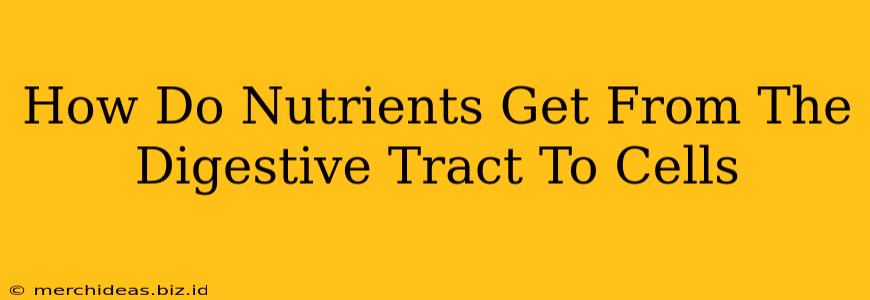The human body is a marvel of efficient transportation. After we eat, the digestive system breaks down food into smaller molecules – nutrients – that the body can use. But how do these vital nutrients actually reach every cell in our vast network of tissues and organs? It's a multi-step process involving several key systems working in harmony. Let's explore this fascinating journey.
The Absorption Process: From Gut to Bloodstream
The primary site of nutrient absorption is the small intestine. Its specialized structure, with finger-like projections called villi and even tinier projections called microvilli, dramatically increases the surface area available for absorbing nutrients. This intricate design allows for maximum efficiency in extracting valuable molecules from digested food.
Different nutrients are absorbed through different mechanisms:
-
Passive Diffusion: Some nutrients, like fatty acids, simply move across the intestinal lining from an area of high concentration (the gut) to an area of low concentration (the bloodstream). This process requires no energy.
-
Facilitated Diffusion: Other nutrients, like fructose (a type of sugar), utilize protein channels within the intestinal cells to cross the membrane. These channels facilitate the movement but still don't require energy expenditure.
-
Active Transport: This energy-intensive process actively pumps nutrients, such as glucose (another type of sugar) and amino acids (the building blocks of proteins), against their concentration gradient. This means moving them from an area of low concentration to an area of high concentration, requiring cellular energy (ATP).
Once absorbed through the intestinal lining, most nutrients enter the bloodstream. Water-soluble nutrients, such as glucose, amino acids, and many vitamins and minerals, are transported via the hepatic portal vein directly to the liver. The liver acts as a processing center, regulating nutrient levels and storing or releasing them as needed throughout the body.
The Lymphatic System: A Pathway for Fats
Fats, after being broken down into fatty acids and glycerol, are absorbed differently. They enter the lymphatic system, a network of vessels that runs parallel to the circulatory system. These fats travel through lymphatic vessels, eventually emptying into the bloodstream near the heart.
Chylomicrons: Fat Transport Packages
Fatty acids and glycerol are reassembled into larger molecules called chylomicrons within the intestinal cells before entering the lymphatic system. These chylomicrons are essentially transport packages that help these fats travel through the lymphatic system and bloodstream.
Delivery to Cells: The Circulatory System's Role
The circulatory system, with its network of arteries, veins, and capillaries, is responsible for delivering nutrients from the bloodstream to individual cells throughout the body. Blood, carrying the absorbed nutrients, flows to every tissue and organ. Capillaries, the smallest blood vessels, have thin walls that allow for easy exchange of nutrients and waste products between the blood and surrounding cells. Each cell then takes up the nutrients it needs to function.
Nutrient Deficiencies: When the System Fails
Problems within any stage of this complex process—from digestion and absorption to transportation and cellular uptake—can lead to nutrient deficiencies. These deficiencies can manifest as various health problems, highlighting the critical importance of a properly functioning digestive and circulatory system. A balanced diet, good gut health, and a healthy circulatory system are essential for optimal nutrient delivery to our cells.
Keywords: nutrient absorption, digestive tract, small intestine, villi, microvilli, passive diffusion, facilitated diffusion, active transport, hepatic portal vein, liver, lymphatic system, chylomicrons, circulatory system, capillaries, nutrient deficiencies, gut health.
